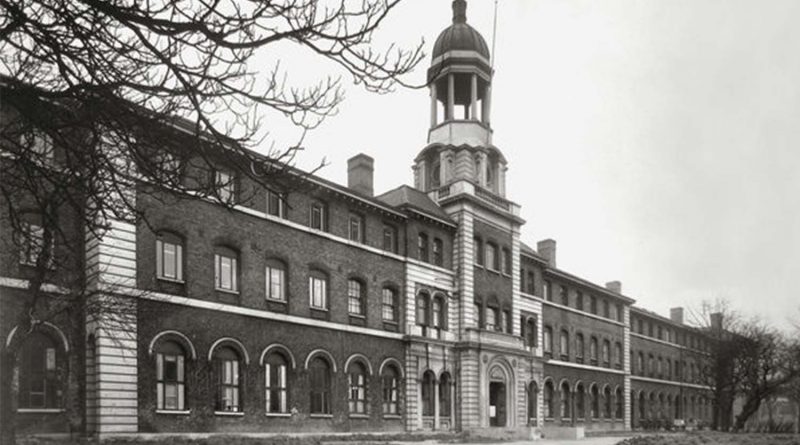Inside the Stepney Union Workhouse, home to East London’s poorest children
Citizen journalist Kate Rutland dives into the records of the Stepney Union Workhouse to unearth the lives of the pauper child inmates.
The Stepney Union Workhouse, which once housed 800 of the East End’s poorest, has left little trace on St Leonard’s Street in Bromley-by-Bow. Heavily bombed during the Second World War and then demolished in the 1960s, blocks of residential flats now occupy the former workhouse site where hundreds of poor Victorians died in miserable conditions.
Pauper children in Stepney and across East London faced extremely hard and brutal day-to-day lives. They mainly did not go to school and often did dangerous and labour-intensive work for example sweeping busy roads or crawling under factory machinery to operate it.
Life for pauper children on the streets also exposed them to the risk of many diseases that were rife such cholera, a disease transmitted by contaminated water. This was a major cause of death among pauper children, and many did not reach adulthood. Therefore, for many children and their families, admission to the workhouse offered them the opportunity of safe shelter and food.
This was a time when the plight of pauper children was becoming higher on the agenda of Victorian philanthropists, including Dr Barnardo. In 1867, he set up a ‘ragged school’ where children could get a free basic education, located on Copperfield Road at the south end of Mile End Park. The Victorians saw poverty as shameful, and the result of laziness. But Barnardo refused to discriminate between the ‘deserving’ and ‘undeserving’ poor.
However, such treatment was rare, and children who entered the workhouse had little hope for such kindness. As the classic novel Oliver Twist tells, workhouse children at that time experienced neglect, abuse and terrible living conditions.
The biggest workhouse in Stepney, the imposing three-story Stepney Union Workhouse, was open between 1863 and 1921 and accommodated up to 800 inmates. The workhouse cost over £30,000 to build and was opened by wealthy coal merchant James Charrington, Chairman of the Board of Guardians of the Stepney Poor Law Union. This group was established in 1836 to manage poor relief in the area following the expansion of government funding.
Just weeks after opening, the Guardians of the Workhouse ordered additional works to be carried out to prevent inmates climbing over the workhouse’s south walls and escaping across the railway lines. Despite the good intentions, it’s not hard to imagine why the inmates sought to escape.
In large workhouses like Stepney Union, children were most commonly separated from their parents, with family members all being sent to their own sections. The Board of Guardians became the legal guardians of orphaned children. Mothers could occasionally be kept with children under seven years old.
Heart-breaking stories of the child inmates of the Stepney Union Workhouse are scattered through the census records. Julia Wilson was abandoned at the workhouse in 1871, aged just 15 months old. Her parents were recorded as ‘in Australia,’ so likely they were deported as convicts. In 1871, older teenage children ranging in age from 13-15 were also listed as inmates without their parents.
Children were sometimes kept with their families, but these families were in dire situations that meant they were repeatedly entering and leaving the workhouse. Amelia Tagg was born in the workhouse in 1911 to parents who had been married for 21 years. She was one of 13 children, nine of which were recorded as deceased. Her father had been admitted multiple times to the workhouse since 1910 but died a year later in the workhouse at the age of 40.
Ellen Peters was a single woman who had been admitted around 20 times between 1907 and 1916. She had two children who were labelled as illegitimate in workhouse records. Her son, Frank, was born in 1908 and was often admitted alongside his mother into the workhouse. Aged two years old, he was housed separately in the Ratcliffe Receiving Home for Children. In 1911, Peters had a second son, Albert, who was born in the workhouse. He was also repeatedly discharged and readmitted to the workhouse with his mother.
Admission to the workhouse was often the last resort for those in extreme poverty as it was seen as shameful and carried a lot of stigmas.
Children born out of wedlock were judged harshly by law officials and labelled as ‘bastard children’. The use of this language would clearly be unacceptable today, but in the early Victorian period, illegitimate children were morally judged for the ‘immoral’ actions of their mothers and fathers.
Pauperism was seen as a moral issue and therefore, to better pauper children, it was thought they should be separated from the influence of their parents and therefore prevent them becoming paupers themselves.
In recognition of this harsh social stigma, from 1904 children born in the Stepney Union Workhouse had their birth recorded at 50A St Leonard’s Street in an attempt to reduce any future disadvantage in their later lives.
Later Stepney’s Poor Laws established new, smaller institutions beyond workhouses to care for children, and changes in the 1900s led to improvements for children in the workhouse. By 1915 children aged three and over were no longer allowed to reside in workhouses. New, smaller institutions beyond workhouses were established to care for poor children.
In 1901, 200 children were sent to a village of cottage homes in Stifford, Essex to be raised in homes of 15 to 20 children. This aimed to give children a more ‘normal’ and family like childhood. Children were being increasingly cared for more closely in smaller institutions, but this type of care was still very different from those for children today.
The children faced harsh lives in the Stepney Union Workhouse often separated from family and heavily judged for their pauperism. However, life in the workhouse – while brutal – was a safety net for those in extreme poverty. Life on the streets was cruel and dangerous so for children, the workhouse often offered them their first opportunity of safety and shelter.
If you enjoyed this article, you might like reading about the story of Pelican Cottage.



Hello,
My grandmother, Hilda Chapman and her sister Emily were sent to live in a workhouse in Bromley Bow at age 10 and 8 when their father died in 1906. There were three younger siblings at home, they being the eldest, were sent away. Is there a listing of the inmates somewhere online to find which home they were sent to? I know she left at age 14 to work as a maid for a wealthy family in England, but not sure where. Any info would be helpful. I love this article, very enlightening. Linda Clark
Charles Dickens describes the schools of the Stepney Union in detail in Chapter XXI of The Uncommercial Traveller. He thought they were doing a wonderful job of educating children who otherwise lived lives of “scrofula, ignorance, wickedness, prostitution, poverty, and felony” on the filthy streets of London.
I remember in the 50’s I befriended a Jamaican boy and his mother who were staying there. I was only about 7 so I don’t remember much but the room they were staying in was like a cell, a very high up window and painted brick walls green on the bottom and a cream halfway up. I can’t remember how they cooked their meals whether they had a communal kitchen or not but I remember that there were so many rooms or cells there. I wonder if the building was being used at the time for displaced persons. At that time I lived in Three Mill Lane just opposite the place.